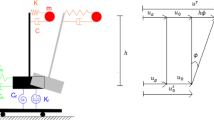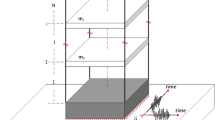Abstract
Considering the effect of soil–structure interaction in dynamic analysis of structures can change their responses. It is generally assumed that the structure is located on a rigid foundation and the flexibility effect of the soil is not considered. Researches on the soil–structure interaction show that the dynamic response of the structures located on a soft and flexible soil is completely different from the dynamic response of the same structure located on a stiff soil. In this paper, the effect of the soil–structure interaction on the response of a single-degree-of-freedom system (Nagasaki airport tower) that is controlled by a modified tuned liquid damper is investigated. The soil effect is modeled using an approximate cone method based on the semi-infinite boundary conditions. First, the governing equations for describing the fluid sloshing obtained with shallow water wave theory are solved by Lax’s finite-difference scheme. Then, the dynamic equilibrium equations for a structure controlled with a modified tuned liquid damper are obtained by considering the effect of soil–structure interaction using Lagrange’s method. These equations are solved numerically by Newmark’s method. The controlled structural responses are calculated in different time steps and compared with the responses of the uncontrolled structure. Results show that the seismic design of the modified tuned liquid damper system can be more effective to reduce the structural responses. Also, this system can reduce efficiently the maximum responses of the structures considering soil–structure interaction effect during a near-fault earthquake.

















Similar content being viewed by others
References
Alavi A, Rahgozar R (2018) Optimal stiffness distribution in preliminary design of tubed-system tall buildings. Struct Eng Mech 65(6):731–739
Alavi A, Rahgozar P, Rahgozar R (2018) Minimum-weight design of high-rise structures subjected to flexural vibration at a desired natural frequency. Struct Des Tall Spec Build 27(15):e1515. https://doi.org/10.1002/tal.1515
Banerji P, Murudi M, Shah AH, Popplewell N (2000) Tuned liquid dampers for controlling earthquake response of structures. Earthq Eng Struct Dyn 29(5):587–602
BHRC (2014) Iranian code of practice for seismic resistant design of buildings, standard 2800 road. Housing and Urban Development Research Center, Iran
Bigdeli Y, Kim D (2016) Damping effects of the passive control devices on structural vibration control: TMD, TLC and TLCD for varying total masses. KSCE J Civ Eng 20(1):301–308
Chang Y, Noormohamed A, Mercan O (2018) Analytical and experimental investigations of modified tuned liquid dampers (MTLDs). J Sound Vib 428:179–194
Di Matteo A, Iacono FL, Navarra G, Pirrotta A (2015) Innovative modeling of tuned liquid column damper motion. Commun Nonlinear Sci Numer Simul 23(1–3):229–244
Fitzgerald B, Basu B (2016) Structural control of wind turbines with soil structure interaction included. Eng Struct 111:131–151
Gholizadeh S, Salajegheh E (2010) Optimal seismic design of steel structures by an efficient soft computing based algorithm. J Constr Steel Res 66(1):85–95
Gholizadeh S, Davoudi H, Fattahi F (2017) Design of steel frames by an enhanced moth-flame optimization algorithm. Steel Compos Struct 24(1):129–140
Gholizadeh S, Razavi N, Shojaei E (2018) Improved black hole and multiverse algorithms for discrete sizing optimization of planar structures. Eng Optim 1:1–23. https://doi.org/10.1080/0305215x.2018.1540697
Heidarzadeh H, Oliaei M (2018a) Development of a generalized model using a new plastic modulus based on bounding surface plasticity. Acta Geotech 13(4):925–941
Heidarzadeh H, Oliaei M (2018b) An efficient generalized plasticity constitutive model with minimal complexity and required parameters. KSCE J Civ Eng 22(4):1109–1120
Huo L, Shen W, Li H, Zhang Y (2013) Optimal design of liquid dampers for structural vibration control based on GA and H∞ Norm. Math Probl Eng 2013:1–10
Imanzadeh S, Marache A, Denis A (2017) Influence of soil spatial variability on possible dysfunction and failure of buried pipe, case study in Pessac city, France. Environ Earth Sci 76(5):212
Imanzadeh S, Hibouche A, Jarno A, Taibi S (2018) Formulating and optimizing the compressive strength of a raw earth concrete by mixture design. Constr Build Mater 163:149–159
Jahanshahi M, Rahgozar R (2013) Optimum location of outrigger-belt truss in tall buildings based on maximization of the belt truss strain energy. Int J Eng Trans A Basics 26(7):693–700
Javdanian H, Heidari A, Kamgar R (2017) Energy-based estimation of soil liquefaction potential using GMDH algorithm. Iran J Sci Technol Trans Civ Eng 41(3):283–295
Jia J (2017) Modern earthquake engineering: offshore and land-based structures. Springer, Berlin
Kamgar R, Khatibinia M (2017) Multi-objective optimization design of tuned mass damper system subjected to critical excitation. Modares Civ Eng J 17(4):153–164
Kamgar R, Rahgozar R (2016) A simple method for determining the response of linear dynamic systems. Asian J Civ Eng 17(6):785–801
Kamgar R, Hatefi SM, Majidi N (2018a) A fuzzy inference system in constructional engineering projects to evaluate the design codes for RC buildings. Civ Eng J 4(9):2155–2172
Kamgar R, Samea P, Khatibinia M (2018b) Optimizing parameters of tuned mass damper subjected to critical earthquake. Struct Des Tall Spec Build 27(7):e1460
Kamgar R, Babadaei Samani MR, Heidarzadeh H (2019a) Optimization of nonlinear viscous damper characteristics to reduce the response of concrete structures with linear and nonlinear behaviours. J Struct Constr Eng. https://doi.org/10.22065/jsce.2019.148073.1659(In Persian)
Kamgar R, Khatibinia M, Khatibinia M (2019b) Optimization criteria for design of tuned mass dampers including soil–structure interaction effect. Int J Optim Civ Eng 9(2):213–232
Khatibinia M, Gholami H, Kamgar R (2018) Optimal design of tuned mass dampers subjected to continuous stationary critical excitation. Int J Dyn Control 6(3):1094–1104
Lee SC, Reddy D (1982) Frequency tuning of offshore platforms by liquid sloshing. Appl Ocean Res 4(4):226–231
Li Z-S, Derfouf F-EM, Benchouk A, Abou-Bekr N, Taibi S, Fleureau J-M (2018) Volume change behavior of two compacted clayey soils under hydraulic and mechanical loadings. J Geotechn Geoenviron Eng 144(4):04018013
Lu M, Popplewell N, Shah A, Chan J (2004) Nutation damper undergoing a coupled motion. J Vib Control 10(9):1313–1334
Malekghasemi H (2011) Experimental and analytical investigations of rectangular tuned liquid dampers (TLDs). Master of Applied Science, University of Toronto, Toronto
Malekinejad M, Rahgozar R, Malekinejad A, Rahgozar P (2016) A continuous–discrete approach for evaluation of natural frequencies and mode shapes of high-rise buildings. Int J Adv Struct Eng 8(3):269–280
Mirjalili S (2015) How effective is the Grey Wolf optimizer in training multi-layer perceptrons. Appl Intell 43(1):150–161
Mirjalili S, Mirjalili SM, Lewis A (2014) Grey wolf optimizer. Adv Eng Softw 69:46–61
Mirjalili S, Saremi S, Mirjalili SM, Coelho LDS (2016) Multi-objective grey wolf optimizer: a novel algorithm for multi-criterion optimization. Expert Syst Appl 47:106–119
Najafzadeh M, Zeinolabedini M (2018) Derivation of optimal equations for prediction of sewage sludge quantity using wavelet conjunction models: an environmental assessment. Environ Sci Pollut Res 25(23):22931–22943
Oliaei M, Manafi E (2015) Static analysis of interaction between twin-tunnels using discrete element method (DEM). Sci Iran Trans A Civ Eng 22(6):1964
Papadopoulos M, Van Beeumen R, François S, Degrande G, Lombaert G (2018) Modal characteristics of structures considering dynamic soil–structure interaction effects. Soil Dynamics and Earthquake Engineering 105:114–118
Preumont A, Seto K (2008) Active control of structures. Wiley, Lonon
Rahgozar P (2015) Effects of soil–structure interaction on adjacent buildings. M.Sc. thesis, Shahid Bahonar University of Kerman, Kerman, Iran
Rao SS, Yap FF (2011) Mechanical vibrations. Prentice Hall, Upper Saddle River
Rostami S, Shojaee S (2018) Development of a direct time integration method based on quartic B-spline collocation method. Iran J Sci Technol Trans Civ Eng 1:21. https://doi.org/10.1007/s40996-018-0193-1
Samanta A, Banerji P (2010) Structural vibration control using modified tuned liquid dampers. IES J Part A Civ Struct Eng 3(1):14–27
Shimizu T, Hayama S (1987) Nonlinear response of sloshing based on the shallow water wave theory: vibration, control engineering, engineering for industry. JSME Int J 30(263):806–813
Soliman I, Tait M, El Damatty A (2017) Modeling and analysis of a structure semi-active tuned liquid damper system. J Struct Control Health Monit 24(2):e1865
Soong TT, Dargush GF (1997) Passive energy dissipation systems in structural engineering. Willey, New York
Stewart J, Crouse C, Hutchinson TC, Lizundia B, Naeim F, Ostadan F (2012) Soil–structure interaction for building structures. National Institute of Standards and Technology and NEHRP Consultants Joint Venture
Sun LM, Fujino Y, Pacheco BM, Isobe M (1989) Nonlinear waves and dynamic pressures in rectangular tuned liquid damper (TLD)—simulation and experimental verification. JSCE Struct Eng Earthq Eng 6(2):251s–262s
Sun L, Fujino Y, Koga K (1995) A model of tuned liquid damper for suppressing pitching motions of structures. Earthq Eng Struct Dyn 24(5):625–636
Vancliver J, Mitome S (1979) Effect of liquid storage tanks on the dynamic response of offshore platform. Appl Ocean Res 1(1):67–74
Veletsos AS, Meek JW (1974) Dynamic behaviour of building-foundation systems. Earthq Eng Struct Dyn 3(2):121–138
Verdugo R, Ishihara K (1996) The steady state of sandy soils. J Jpn Geotech Soc Soils Found 36(2):81–91
Wolf J (1985) Dynamic soil–structure interaction. Prentice hall, New York
Wolf JP, Deeks AJ (2004) Foundation vibration analysis: a strength of materials approach. Elsevier, Butterworth-Heinemann
Yamamoto K, Kawahara M (1999) Structural oscillation control using tuned liquid damper. Comput Struct 71(4):435–446
Zhang Z, Staino A, Basu B, Nielsen SR (2016) Performance evaluation of full-scale tuned liquid dampers (TLDs) for vibration control of large wind turbines using real-time hybrid testing. Eng Struct 126:417–431
Acknowledgements
The authors would like to show their appreciation to HPC center (Shahr-e-Kord University, Iran) for their collaboration in offering computational clusters, which was a great help to complete this work.
Funding
This study has not been funded.
Author information
Authors and Affiliations
Corresponding author
Ethics declarations
Conflict of interest
The authors declare that they have no conflict of interest.
Rights and permissions
About this article
Cite this article
Kamgar, R., Gholami, F., Zarif Sanayei, H.R. et al. Modified Tuned Liquid Dampers for Seismic Protection of Buildings Considering Soil–Structure Interaction Effects. Iran J Sci Technol Trans Civ Eng 44, 339–354 (2020). https://doi.org/10.1007/s40996-019-00302-x
Received:
Accepted:
Published:
Issue Date:
DOI: https://doi.org/10.1007/s40996-019-00302-x




